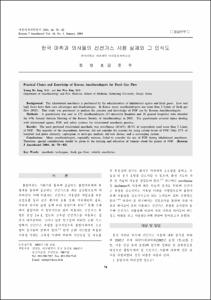KUMEL Repository
1. Journal Papers (연구논문)
1. School of Medicine (의과대학)
Dept. of Anesthesiology & Pain Medicine (마취통증의학)
한국 마취과 의사들의 신선가스 사용 실제와 그 인식도
- Keimyung Author(s)
- Jang, Young Ho
- Journal Title
- 대한마취과학회지
- Issued Date
- 2004
- Volume
- 46
- Issue
- 1
- Abstract
- Background: The inhalational anesthesia is performed by the administration of inhalational agents and fresh gases. Low and high flows have their own advantages and disadvantages. In Korea, many anesthesiologists use more than 2 L/min of fresh gas flow (FGF). This study was performed to analyze the practice and knowledge of FGF use by Korean Anesthesiologists.
Methods: A questionaire was sent to 122 anesthesiologists (15 university hospitals and 16 general hospitals) who attended the 47th Annual Autumn Meeting of the Korean Society of Anesthesiology in 2002. The questionaire covered topics dealing with inhalational agents, FGF, and safety systems for inhalational anesthesia practice.
Results: The most preferred inhalational anesthetic was sevoflurane (65.6%). 88.5% of respondents used more than 2 L/min of FGF. The majority of the respondents, however, did not consider the reasons for using certain levels of FGF. Only 27% of hospitals had pulse oximetry, capnogram or muti-gas analysis, fail-safe device, and a scavenging system.
Conclusions: Many anesthesiologists, especially trainees, failed to consider the use of FGF during inhalational anesthesia. Therefore, special consideration should be given to the training and education of trainees about the proper of FGF. (Korean J Anesthesiol 2004; 46: 78∼82)
Key Words: anesthetic techniques, fresh gas flow, volatile anesthetics.
- Alternative Title
- Practical Choice and Knowledge of Korean Anesthesiologists for Fresh Gas Flow
- Keimyung Author(s)(Kor)
- 장영호
- Publisher
- School of Medicine
- Citation
- 장영호 et al. (2004). 한국 마취과 의사들의 신선가스 사용 실제와 그 인식도. 대한마취과학회지, 46(1), 78~82-78~82. doi: 10.4097/kjae.2004.46.1.78
- Type
- Article
- ISSN
- 0302-5780
- Appears in Collections:
- 1. School of Medicine (의과대학) > Dept. of Anesthesiology & Pain Medicine (마취통증의학)
- 파일 목록
-
-
Download
 oak-bbb-870.pdf
기타 데이터 / 209.1 kB / Adobe PDF
oak-bbb-870.pdf
기타 데이터 / 209.1 kB / Adobe PDF
-
Items in Repository are protected by copyright, with all rights reserved, unless otherwise indicated.